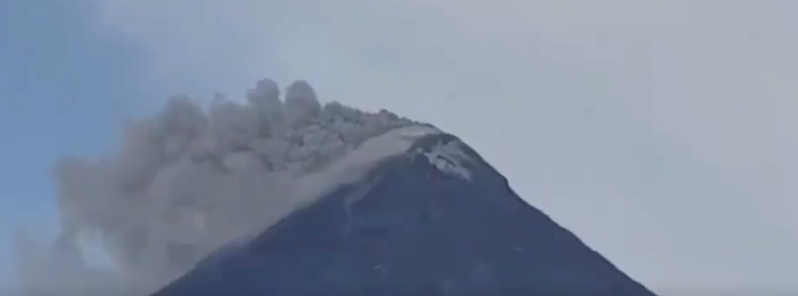Phreatic eruptions at Mayon volcano, Philippines

Two phreatic eruption events were observed at 00:17 and 00:28 UTC (08:17 and 08:28 LT) on December 27, 2018. These events generated grayish to grayish white ash plume that rose 600 meters (2 000 feet) and 200 meters (650 feet) above the summit, respectively, before drifting southwest.
According to PHIVOLCS, Mayon Volcano’s seismic monitoring network recorded one volcanic earthquake during the 24-hour observation period and fair crater glow from the summit could be observed at night.
Sulfur dioxide (SO2) emission was measured at an average of 1943 tonnes/day on November 25, 2018. Precise leveling data obtained between October 22 and 31, 2018 indicate inflation of the edifice in the southeast sector while the north sector indicates short-term deflation relative to August 30 to September 3, 2018.
Overall, however, the volcano generally remains inflated relative to 2010 baselines. Electronic tilt data further show pronounced inflation of the mid-slopes beginning June 25, 2018, possibly due to aseismic magma intrusion deep beneath the edifice.
Our Mayon Volcano paying tribute to our Queen, Catriona Gray!
December 27, 2018, 8:19 AM#CatrionaGray #MissUniverse #Philippines #lavawalk #lavagown #MayonVolcano #Albay pic.twitter.com/F7gSFb3Rfn
— k i t (@jddmgc) December 27, 2018
JUST IN: Mayon Volcano spewed grayish ash plumes around 8:40 a.m. today. | via @LucesNino pic.twitter.com/VpPMu14yyX
— Manila Bulletin News (@manilabulletin) December 27, 2018
PHIVOLCS maintains Alert Level 2 – moderate level of unrest. The public is reminded that sudden explosions, lava collapses, pyroclastic density currents or PDCs and ashfall can still occur and threaten areas in the upper to middle slopes of Mayon.
A 6-km (3.7 miles) Permanent Danger Zone or PDZ and a precautionary 7 km (4.3 miles) Extended Danger Zone or EDZ in the south-southwest to east-northeast sector, stretching from Anoling, Camalig to Sta. Misericordia, Sto. Domingo must be strictly prohibited.
People residing close to these danger areas are also advised to observe precautions associated with rockfalls, PDCs and ashfall.
Active stream/river channels and those identified as perennially lahar-prone areas on all sectors of the volcano should also be avoided especially during extreme weather conditions when there is heavy and prolonged rainfall.
Civil aviation authorities must advise pilots to avoid flying close to the volcano’s summit as airborne ash and ballistic fragments from sudden explosions and PDCs may pose hazards to aircraft.
Featured image: Mayon volcano erupting on December 27, 2018. Credit: @LucesNino

Commenting rules and guidelines
We value the thoughts and opinions of our readers and welcome healthy discussions on our website. In order to maintain a respectful and positive community, we ask that all commenters follow these rules:
We reserve the right to remove any comments that violate these rules. By commenting on our website, you agree to abide by these guidelines. Thank you for helping to create a positive and welcoming environment for all.